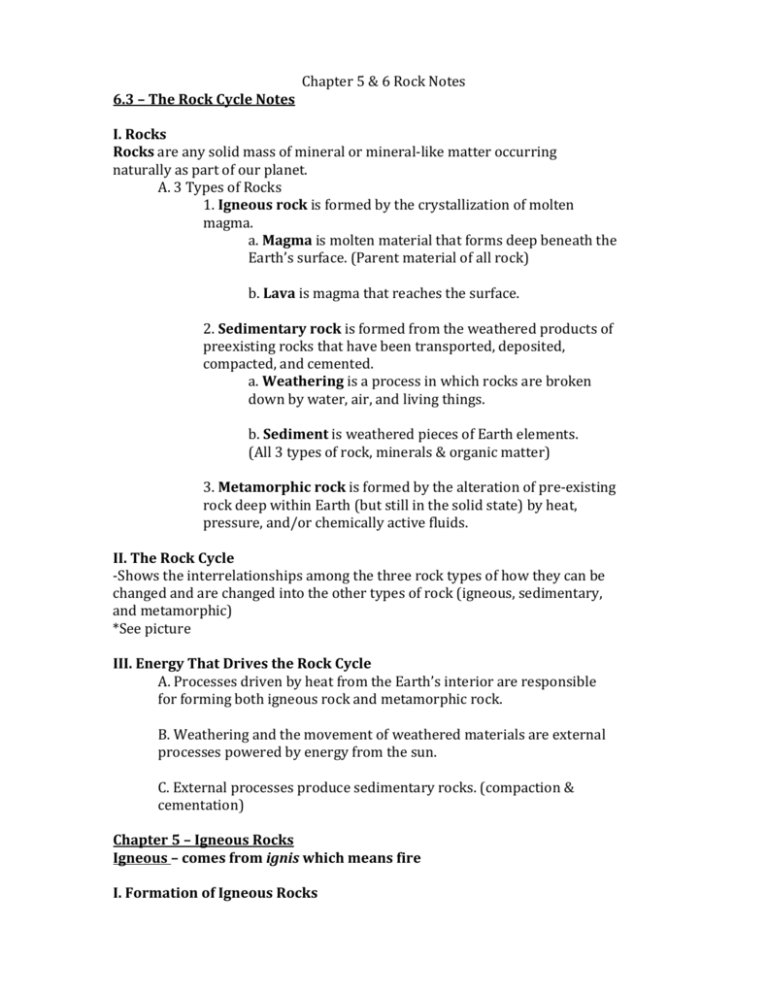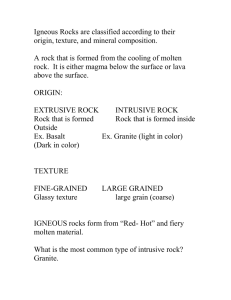Chapter 5 & 6 Rock Notes 6.3 – The Rock Cycle Notes I. Rocks
advertisement

Chapter 5 & 6 Rock Notes 6.3 – The Rock Cycle Notes I. Rocks Rocks are any solid mass of mineral or mineral-­‐like matter occurring naturally as part of our planet. A. 3 Types of Rocks 1. Igneous rock is formed by the crystallization of molten magma. a. Magma is molten material that forms deep beneath the Earth’s surface. (Parent material of all rock) b. Lava is magma that reaches the surface. 2. Sedimentary rock is formed from the weathered products of preexisting rocks that have been transported, deposited, compacted, and cemented. a. Weathering is a process in which rocks are broken down by water, air, and living things. b. Sediment is weathered pieces of Earth elements. (All 3 types of rock, minerals & organic matter) 3. Metamorphic rock is formed by the alteration of pre-­‐existing rock deep within Earth (but still in the solid state) by heat, pressure, and/or chemically active fluids. II. The Rock Cycle -­‐Shows the interrelationships among the three rock types of how they can be changed and are changed into the other types of rock (igneous, sedimentary, and metamorphic) *See picture III. Energy That Drives the Rock Cycle A. Processes driven by heat from the Earth’s interior are responsible for forming both igneous rock and metamorphic rock. B. Weathering and the movement of weathered materials are external processes powered by energy from the sun. C. External processes produce sedimentary rocks. (compaction & cementation) Chapter 5 – Igneous Rocks Igneous – comes from ignis which means fire I. Formation of Igneous Rocks A. Intrusive igneous rocks are formed when magma hardens beneath Earth’s surface slowly. (Large/coarse crystals) B. Extrusive igneous rocks are formed when lava hardens. Quick cooling (small/fine crystals) II. Classification of Igneous Rocks -­‐ Igneous rocks can be classified based on their composition and texture. A. Texture • Coarse-­‐grained texture is caused by slow cooling resulting in larger crystals • Fine-­‐grained texture is caused by rapid cooling resulting in smaller, interconnected mineral grains • Glassy texture is caused by very rapid cooling a. Obsidian-­ has a glassy appearance because no gases got trapped with in the rock as it cooled b. Pumice-­has a rough bumpy appearance because there were gasses trapped with in the rock when it cooled • Porphyritic texture (porphyry) is caused by different rates of cooling resulting in varied sized minerals (will contain both large and fine crystals) B. Composition • Granitic composition rocks are made mostly of light-­‐colored minerals quartz and feldspar. (Made from Felsic magma which is made up mostly of silicon) *Will find it mainly on the continents • Basaltic composition rocks are made mostly of dark-­‐colored minerals silicate minerals and plagioclase feldspar. (Made from Mafic Magma, which is made up of Iron) *You will find it mainly on the ocean floor • Andesitic composition rocks are between granitic light-­‐color minerals and basaltic composition dark-­‐colored minerals. (Made up of both mafic & felsic magma) • Ultramafic very dark rocks that are made mostly of dark minerals from iron and magnesium-­‐rich minerals. C. Igneous Rock Structures 1. Two Main Types (intrusions & extrusions) a. Intrusions-­‐ underground rock masses of igneous rock i) Batholith-­‐ Largest igneous intrusion that covers 100 square kilometers and over. ii) Stock-­ An igneous intrusion that covers less than 100 square kilometers. iii)Laccolith-­ The floor of an intrusion that is parallel to the rock layer beneath it, and the top is mushroom shaped. iv) Sill-­ An igneous intrusion that lies parallel to and between rock layers (horizontal) v) Dike-­ An igneous intrusion that cuts across rock layers (diagonal to vertical) b. Extrusions-­ igneous rock structures found on the surface of the Earth i) Volcanic Neck-­‐ A solidified central vent of an extinct volcano. ii) Lava Plateau-­‐ forms from repeated lava flows








